There are a number of reasons why people might look for YouTube alternatives. People may look for alternatives to the platform if they are worried about their data privacy and invasive ads. People prefer a wider variety of content and less algorithmic manipulation of their viewing habits. The policies of YouTube may limit some creators or lead them to look for other platforms with more generous revenue-sharing schemes.
Platforms that provide content not found on mainstream sites or align more closely with users’ values may attract users for cultural or political reasons. Another case could be, being banned from the platform or the partnership program.
Aside from TikTok, Facebook streaming, and IGTV, this article looks at five (5) other alternatives to YouTube.
Read also: YouTube launches content creator app ‘YouTube Create’
Vimeo
It should come as no surprise that Vimeo is the preferred platform for creative individuals, given that real filmmakers established it. Vimeo is used by photographers, video content creators, musicians, and advertising agencies, among many others.
With its superior video quality (4K Ultra HD, to be exact) and user-friendly interface, it easily outshines YouTube. Vimeo is ad-free and has a built-in community where users can share videos, comment, and follow channels. Without a doubt, it’s one of the best places to upload videos.
The benefits include ad-free viewing options, a professional user base, and high-quality content. The downsides include a need for more variety compared to YouTube, the need to pay for premium features, and constrained capabilities for social media.
Dailymotion
As one of YouTube’s main rivals, Dailymotion draws 112 million unique visitors per month. Some think it’s the closest thing to YouTube, while others refer to it as “the darker and poorer” sibling. The design, user experience, search functionality, and content categories are all identical to YouTube.
The high quality of the videos is the main reason users choose Dailymotion. While YouTube typically compresses videos, Dailymotion lets users upload up to 4GB in size with 1080p resolution. The major drawback is that videos on Dailymotion can only be 20 minutes long.
A lot of content variety, an interface that’s easy to use, and it’s similar to YouTube are all positives. Downsides: ads can be annoying, content needs to be more organised, and there aren’t many ways to watch live.
Twitch
As a substitute for YouTube, Twitch has many benefits. The main emphasis is on live streaming, which creates a more interactive experience by allowing content creators and viewers to engage in real time. Although it is most commonly used for gaming content, this format also applies to other types of streaming media, such as music, art, and lifestyle. Unlike YouTube, Twitch gives content creators various ways to make money, such as subscriptions, donations, and ads. In addition, the chat rooms and emotes that are part of Twitch’s community features help foster a close-knit environment for creators and viewers.
Having said that, Twitch is not without its flaws. The platform may restrict access to previously recorded videos due to its focus on live streaming. For those who’d rather work with scripts or edits, this could be a setback. Because the platform depends on user engagement and discoverability algorithms, smaller creators might find it difficult to gain traction. This problem should disappear if you can put in the effort to get momentum.
PeerTube
PeerTube is a video-sharing platform created by the French nonprofit organisation Framasoft. It is open-source and independent. It comprises multiple servers managed by diverse groups of individuals and is not controlled by a single large corporation.
Due to its decentralised nature, PeerTube hosts a wide variety of content, from instructional videos to humorous clips. To spare you the annoyance of intrusive targeted ads, it does not employ hidden algorithms or monitor your web browsing habits.
Benefits include being less commercialised than YouTube, being community-driven, having diverse content, being decentralised, and focusing on freedom. Downsides: fewer users and difficulties in discovering content. The downsides can be overcome if the platform gains popularity.
DTube
DTube touts itself as a decentralised YouTube alternative that uses P2P networks and blockchain technology. There are a number of benefits to this method. One benefit of decentralisation is the increased likelihood of less censorship and more free speech because no one entity has sway over the content.
DTube asserts that it provides better revenue-sharing models for creators by cutting out middlemen and paying creators in cryptocurrency directly. Creators who are unhappy with YouTube’s ad-based revenue system or are looking for other ways to make money may find this appealing.
By storing content on decentralised networks instead of centralised servers, DTube reduces the risk of data breaches or unauthorised access, emphasising data privacy. DTube combats copyright infringement and revenue attribution problems that afflict centralised platforms by utilising blockchain technology, which offers transparency in content ownership and monetisation.
Disadvantages of DTube exist as well. Due to its niche nature, the platform may have a different level of popularity than YouTube, which could reduce the exposure and influence of user-generated content. Compared to centralised platforms, decentralised storage may cause slower loading times and less reliable access to content, but it does offer privacy and security benefits. For producers and audiences who aren’t familiar with blockchain technology or are wary of cryptocurrency’s legitimacy and volatility, the use of cryptocurrency as payment might be a turnoff.
YouTube might be the leading video content platform, but it is not perfect. If you ever need an alternative, you have the above options to try out, weighing the pros and cons.
















